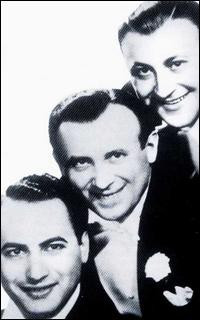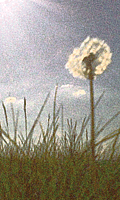


NEWS:
Only 2 days left to hear our September stream - otherwise go to MixCloud to listen but without detailed artist/gig info
Artist Info
|
The Three Suns  Image from Discogs  Reputed to be Mamie Eisenhower's favorite group, the Three Suns are the leading small group in space age pop. Brothers Al and Morty grew up in Brooklyn, where they joined with their cousin, Artie Dunn, as a trio, Al switching from violin to guitar to pick up more gigs. After a year or two working around New York City, they got their first serious show at the Adelphia Hotel in Philadelphia in 1939 and then moved on the Circus lounge of the Hotel Picadilly in New York in 1940, where a two-week engagement turned into a seven-year stay. Reputed to be Mamie Eisenhower's favorite group, the Three Suns are the leading small group in space age pop. Brothers Al and Morty grew up in Brooklyn, where they joined with their cousin, Artie Dunn, as a trio, Al switching from violin to guitar to pick up more gigs. After a year or two working around New York City, they got their first serious show at the Adelphia Hotel in Philadelphia in 1939 and then moved on the Circus lounge of the Hotel Picadilly in New York in 1940, where a two-week engagement turned into a seven-year stay.They had their first hit in 1944, with "Twilight Time," and their cover of "Peg O' My Heart," released just after the Harmonicats' version came out, contended with it for the #1 spot. The Three Suns were a concept as much as a group, since Al Nevins dropped and added players to suit the material. In the late 1940s, the group was a quintet, with a rhythm guitar and bass added. Their first big hit, "Twilight Time," written by Morty Nevins, went on to have over 3 million air plays, according to BMI. In 1951, they recorded as a quintet with Marty Gold on organ and Larry Green on piano. They also recorded as a quartet with Ray Bohr on pipe organ (and later, on "Swinging on a Star," with R&B sax legend King Curtis!), as a sextet, a septet (with Billy Mure on second guitar), a combo of 13 (on "Perdido," 1954), and with orchestral accompaniment. Nevins himself stopped performing live in 1954 and concentrated on producing and publishing. Johnny Buck and later Joe Negri replaced him on guitar. Artie Dunn then reformed the group for live performances in 1957 with Tony Lovello on accordion and Johnny Romano on guitar. Morty Nevins went into studio work as an arranger and composer, and Al Nevins formed a music publishing house, Aldon Music, with Don Kirshner. Aldon Music, located at 1650 Broadway, was just across the street from the legendary Brill Building. Nevins and Kirschner signed many of New York's best young songwriters and Aldon Music placed over 200 songs on the Top 40 charts, including "Will You Still Love Me Tomorrow" and "Up On The Roof" by Gerry Goffin and Carole King, "Breaking Up Is Hard To Do" by Neil Sedaka and Howard Greenfield, and "Uptown" by Barry Mann and Cynthia Weil. Aldon Music was bought by Columbia Pictures-Screen Gems in 1964. Kirschner took over as head of the music company, and Al Nevins retired. The Three Suns became considerably more experimental after Nevins formed Aldon Music. Al suffered a series of major heart attacks in the early 1960s that forced him out of performing, and he began to shift the producing work to others. Many of the later albums are credited to "Nevins, Kirschner Associate" and list no players. Al Nevins was willing to experiment with the best of them, and hired such bold arrangers as Sid Ramin, Marty Gold, and Roy Glover. He liked to toss in unusual instruments and sounds, such as the celestine, a theater pipe organ, castanets, vibes, a six-guitar combo, and what I think is a musical saw (on "One Enchanted Evening"). The best of the later albums were arranged by Charles Albertine. Nevins also recorded three albums of soft orchestral music for RCA under his own name. In the late 1960s, Morty Nevins revived the Three Suns, this time featuring Vinnie Bell on miscellaneous guitar paraphenalia and Fred Mendelsohn on organ, for Musicor Records. Among cognoscenti, "Fever and Smoke," "Movin' and Groovin'," "On a Magic Carpet," "Twilight Memories," and "A Swingin' Thing" are considered the albums to seek out. "Danny's Inferno," from "Movin' and Groovin'," is included on more recent exotica compilations than perhaps any other cut and is one of the leading examples of a classical kitsch number. For more information on the Three Suns in their various instantiations, check out Michael Toth's excellent website, the Three Suns Universe. Read more on Last.fm. User-contributed text is available under the Creative Commons By-SA License; additional terms may apply. Artist biography from last.fm Some other places to look for information: last.fm Discogs MusicBrainz |
